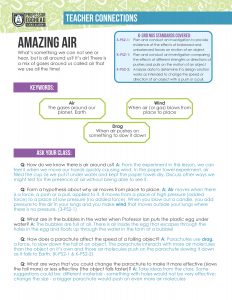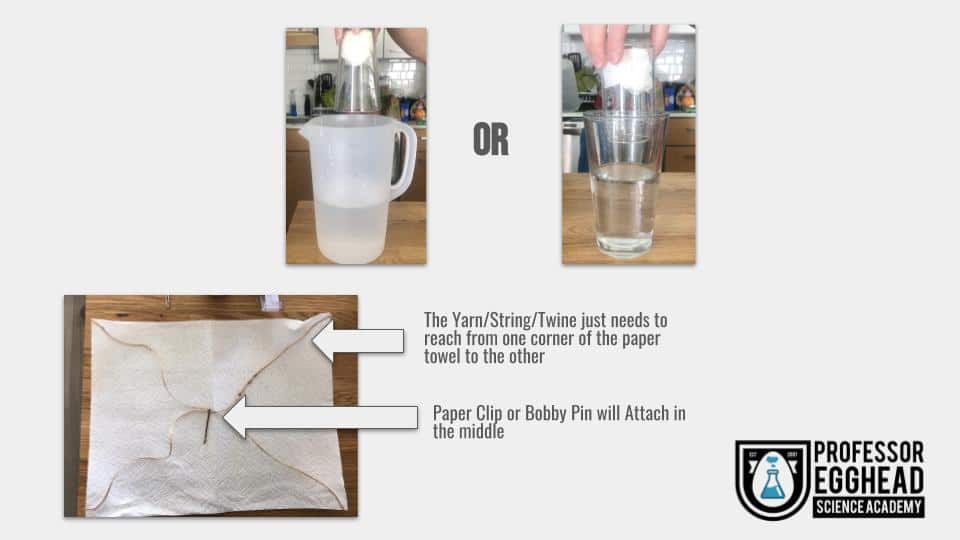Air is all around us but isn’t always visible. We can feel air when it blows from place to place because of pressure and we can tell that is is all around us because it takes up space. When an object moves through the air, it slows down because air is pushing on it - we call this drag.
Keywords
- Air
- Atmosphere
- Air Pressure
- Surface Area
- Air Resistance
materials list
background
Earth is pretty warm - on average it’s about 60 degrees F. Outerspace is around -454.81 degrees F. We get heat from the sun, and at night, when we’re not facing the sun it still stays way warmer than -450 degrees. This is due to our atmosphere trapping that heat in and keeping the planet warm enough for us to live on it. An ATMOSPHERE is made of a mix or different gases held close to the planet by gravity. Here on earth, our atmosphere has a special name: AIR. Air is the mixture of gases that people, animals, and plants breathe - mainly Nitrogen and Oxygen. Air is a mix of gases, and gases are made of molecules. Molecules have mass and since air is made of molecules it must have mass.
Like all objects on earth, air molecules are pulled towards the planet by gravity. Have the students annotate which direction gravity pulls. The measurement we use to weight air is called AIR PRESSURE. This is how much air pushes on other objects. The further we go from the surface of the planet, the less gravity pulls on the air, so there is less of it at high altitudes. Additionally if you made a box 1in x 1in x the height of the atmosphere, the height would be longer at sea level than at the peak of Mt. Everest. That weight is the pressure measured in pounds per square inch. We can see the difference by comparing the pressure at different altitudes: at sea level, the air in that box would weigh about 15 pounds. As you go up to higher altitudes, the height of that box gets smaller, so at the peak of Everest, the box would only weigh about 5 pounds.
Since air is made of molecules, objects moving through it have to push the molecules out of the way. The molecules in solids and liquids are held much closer together, so it’s harder to move through them. For example, if you were in a room of 50 people and you wanted to get to the other side of the room, you’d have to wiggle between each person. This represents liquids. If you had the same room, but only 10 people, it’d be really easy to get to the other side.
When the air pushes back on something, it creates AIR RESISTANCE. It pushes on something more than others because of the object’s SURFACE AREA, or how much space the outside of an object takes up. Back to the room example, if you spread your arms and legs out and move through the room, you'd be more likely to run into the other people regardless of how many people were there. If you balled up really small, you’d be less likely. You’re changing your surface area. When the paper is flat, it has a lot of surface area. When we ball it up, a lot of that surface is now crumpled up so it’s total surface area is less than the flat paper. Objects with a lot of surface area, like the flat paper, create a lot of AIR RESISTANCE. There’s more space on the flat side of the paper for the air to push against to slow it down. Gravity pulls on all objects equally - air resistance and drag that slows some objects down when they fall.
keywords
ATMOSPHERE: The gases around any planet.
AIR RESISTANCE: When air pushes on something and slows it down.
SURFACE AREA: How much space the outside of an object takes up.
AIR PRESSURE: How much air pushes on something.
science standards
K-PS2-1 : Plan and conduct an investigation to compare the effects of different strengths or different directions of pushes and pulls on the motion of an object
3-PS2-1 : Plan and conduct an investigation to provide evidence of the effects of balanced and unbalanced forces on the motion of an object.
3-PS2-2 : Make observations and/or measurements of an object’s motion to provide evidence that a pattern can be used to predict future motion


